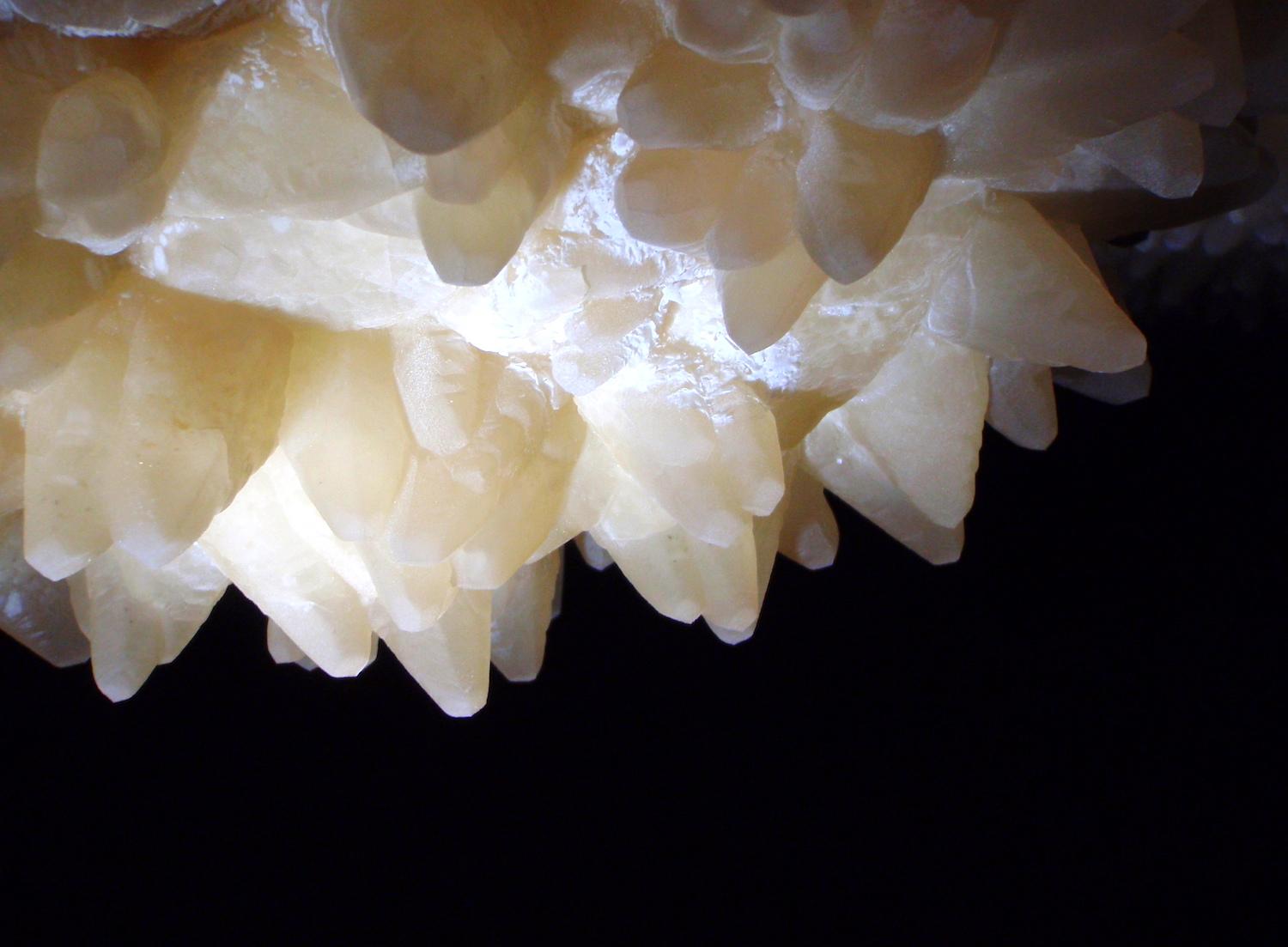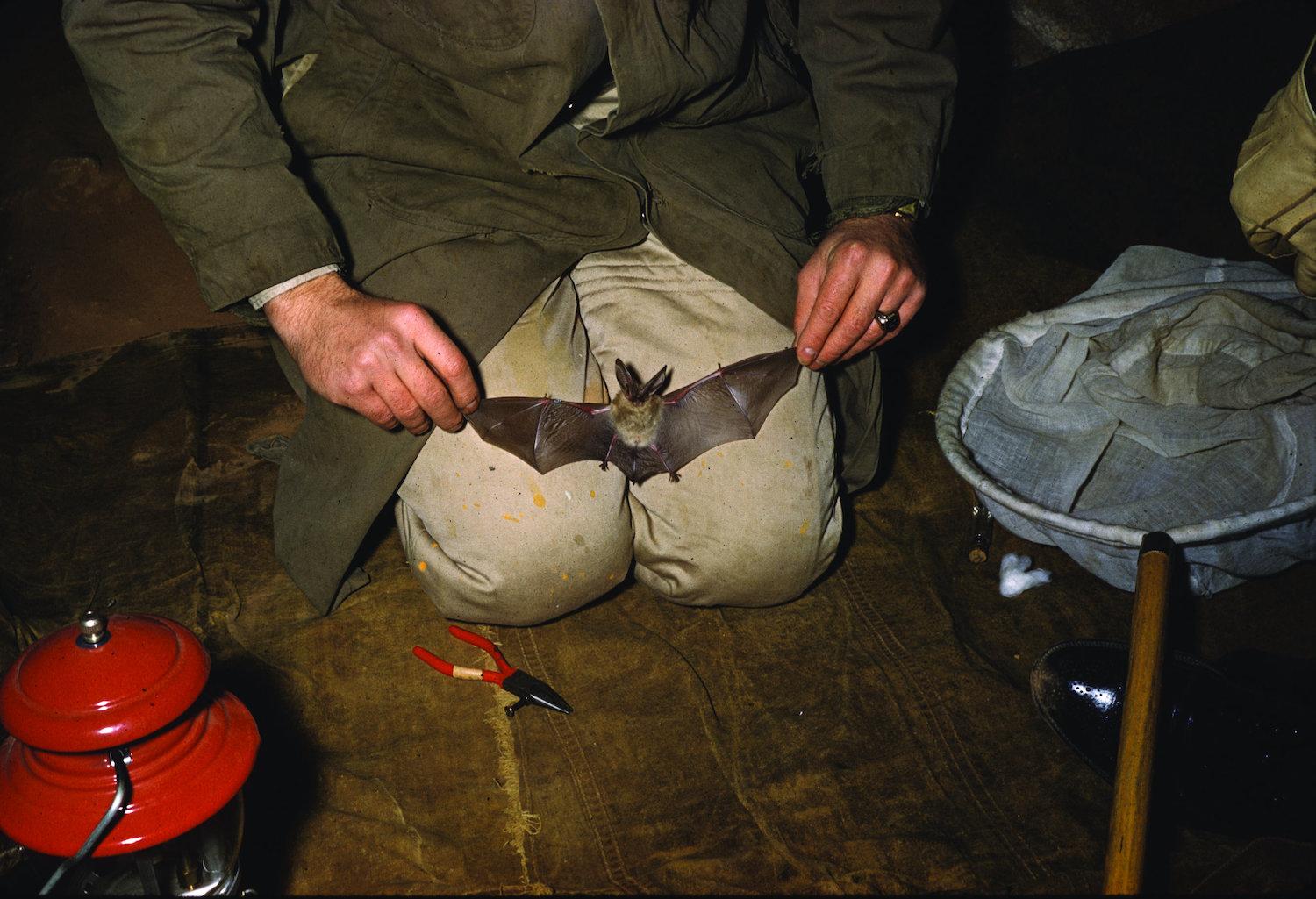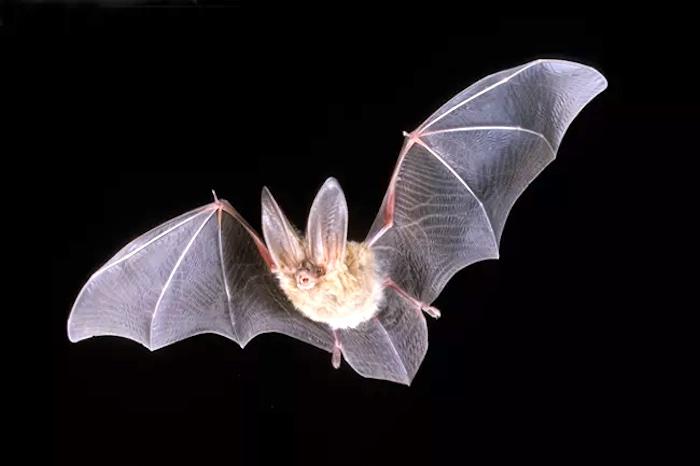
Calcite crystals are common formations in Jewel Cave, and a number of bat species are common visitors/NPS file
Protecting Bats At Jewel Cave National Monument
By Patrick Cone
Beneath South Dakota's Black Hills, just 30 miles from the busy crowds at Mount Rushmore National Memorial, lies a world of deep passages, pristine lakes, and unique geologic features at Jewel Cave National Monument. With more than 200 miles of mapped passageways, it’s the fifth-longest cave system in the world, and has been enthralling visitors since its establishment in 1908.
Brothers Frank and Albert Michaud thought the glittering formations they spied in 1900 through the cave's historic entrance might bring them riches, and filed the “Jewel Tunnel Lode” mining claim.
Jewel Cave practically shimmers with the world’s greatest concentration of bright white dogtooth spar, colorful soda straws, flowstone, and cave bacon. While the calcite creations were not valuable in their own right, the brothers turned the cave into a tourist attraction. They were ahead of their time, though; tourism of the cave didn’t take off as they envisioned. In 1908, President Theodore Roosevelt designated it as a national monument, and soon thereafter the federal government bought out the brothers and placed Jewel Cave under control of the U.S. Forest Service, which turned it over to the National Park Service in 1933.
These days you can explore part of the monument's underworld during ranger-led scenic tours that last approximately 90 minutes as you navigate a half-mile loop with more than 700 stairs. The more adventurous can squeeze through tight passes on the Wild Caving tour, or take an Historic Lantern tour led by rangers in century-old costumes. But no one will be truly alone: the cave is also the home hundreds of bats, from nine different species.
Away from the general public’s cave tours, both Jewel Cave and nearby Wind Cave National Park contain passages that lead to “lakes,” areas where the water table meets the passageways, and odd formations.

Park staff keeps track of bats with bands they attach to them/NPS file
Mike Wiles, the chief of resource management at Jewel Cave, is well-versed in both the underground geology and the bats that roost there.
“Bats in the summer come and go, but a significant number use the cave as a hibernaculum in the winter," he said, referring to the roost sites the bats use in winter. And, they’re not necessarily the same bats every year, but somehow their instincts lead them back to Jewel Cave. Wiles uses internal transponders to track the bats, but it’s easier to count them in the midwinter as when they are hibernating.
More than half of the resident bats are the Townsend’s big-eared bats (c.townsendii), which are well named, as the ears on these gray and tan bats can be over an 1 ½ inches long. The rest of the bats are from the species Myotis, and a few Big Brown bats, but populations are fluid. “The little brown bat population dropped 97 percent recently, because of White Nose Syndrome,” said Wiles, referring to a fungus that has been spreading to many caves across the country. Two species live outdoors at the monument during the summer: the Silver-haired bats roost in the ponderosa pine forests during the daytime, as do the Hoary bats, with their heavy fur coats.
While bats might creep some visitors out, they are an important and essential part of our ecosystem. They eat bugs, pollinate flowers and disperse seeds. A single little brown bat (M. lucifugus) can eat hundreds of mosquitos every hour. And elsewhere, their droppings, or guano, are often used to fertilize gardens. Their habitat has been threatened by development, climate change, and disease, but at Jewel Cave they have found a safe home. To protect hibernating bats, no visitors are allowed through the historic entrance from October through May. While bats traditionally only have one young per year, they can live as long as three decades. However, average life span for the Townsends big-eared bat is 16 years, and 6 ½ years for the little brown bat.

Townsend's big-eared bat in flight/NPS file
Jewel Cave has many different temperatures and levels, giving plenty of wall and ceiling roosting sites, as well as good airflow. The gated entrance in the winter also prevents unauthorized access but horizontal bars let the bats easily escape.
To help these essential bat populations, the Black Hills Parks & Forests Association, in partnership with the National Park Service and Wild Tribute, a clothing company that donates a percentage of its revenues to park projects across the country, formed an Adopt-A-Bat program in 2018. Donations go towards resource management, bat conservation, and bat research efforts for the bats at Jewel Cave National. To date the program has raised more than $40,000.
Patty Ressler is the executive director at the Black Hills Parks & Forests Association, which has been partnering with Jewel Cave National Monument since 1984. “The park was looking for ways to support bat population. We had already done that with the Wind Cave's bison adoption program," she said. "It’s a great way for us to help our parks, and talk about how important bats are and help support the bat population. We print a small brochure that people can pick up, which talks about the importance of bats and how important they are to the ecosystem.”
The association's bat adoption program seeks a $35 donation, which in turn gets you "your choice of a large plush bat or a hat that has a Townsends long ear bat on the front, and on the back, it says, ‘I adopted a bat at Jewel Cave National Monument’,” said Ressler.
Wild Tribute contributes 4 percent from sales of these products, with the funds going towards the adoption program. Some of the money raised so far has helped the National Park Service purchase some sonar equipment to help them track the bat population. And of course, participants do not get to take home one of these unique individuals, but know that they are helping them survive deep within Jewel Cave.
Bat Myths, courtesy of Black Hills Parks & Forests Association
Bats are Blind — Bats actually have vision comparable to the average human in the daylight even though they spend the majority of their time in dark environments. In the dark bats use echolocation (the process of navigating by sound) to produce ultra-high frequency sounds that travel outward, bounce off objects and then return back to the bat. These sounds are then interpreted by the bats as spatial information. Bats complete the process of sending, receiving and interpreting these sounds 200 or more times every second. They can even easily detect objects as thin as a human hair.
All Bats Suck Blood — Vampire bats do exist, but they only make up approximate one-quarter of one percent of all bat species and none found in the United States or Canada. Vampire bats actually supply an anticoagulant in their saliva that is the base for an effective treatment for blood clots.
Bats Carry Rabies — All mammals can contract rabies, but bats rarely do so. Their agile flying and reclusive roosting behavior keep them largely out of contact with other disease carrying

Comments
You should update the information about Wild Tribute. Their website says they donate $20 of the $35 they charge for the bat/hat, not just four percent.
Thanks for the article; I think a few people I know might be getting bats for Christmas this year!